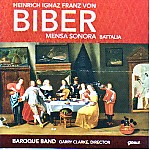Biber’s Mensa Sonora (“Sonorous Table”) doesn’t get as much play as some of his more virtuosic violin works, but it contains splendid music nonetheless. By any standard this is an excellent performance for a period-instrument group, largely because director Garry Clarke made the smart decision to use a larger-size ensemble rather than having the music played one to a part. In his booklet notes Clarke offers all kinds of ridiculous “historical” reasons supporting this decision, and it’s sad that today it is unacceptable for period-instrument performers to offer the one reason that we know would have been as valid in the composer’s own time as it is in ours: the music sounds better this way.
Mensa Sonora consists of six parts (called “Pars” appropriately enough), each containing from five to seven brief movements. These range from delicate arias and sarabandes to the vigorous and rhythmically inventive second Balletto from Pars II, and including a couple of imposing Chaconnes (in Pars III and VI). A larger ensemble gives more weight and sonority (that’s “Sonora”, right?) to the big moments, and a richer but still intimate sound to the lighter ones. Sure, there’s the usual minimization of vibrato, which is wrong, but with multiple players it matters less than usual, and to his credit Clarke permits them none of that whiny squeezing of notes that so many period ensembles deploy to the point of mannerism in lyrical passages.
The Battalia makes a substantial bonus. Clarke and his company really play up the battle scene, and the drunken soldiers make a jolly cacophony. Only the final lament of the dying doesn’t quite work–it seems to me that it should be simply touching and played more or less straight, without the lachrymose chromaticism exaggerated quite so much. Of course, this is very much a matter of taste. As usual with this label, the engineering is superbly natural and well-balanced. A fine disc that all fans of Baroque music will want to consider. [2/18/2010]
































